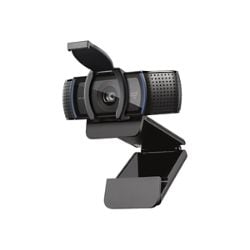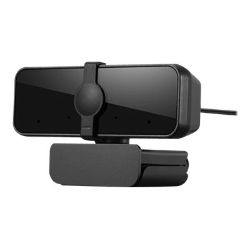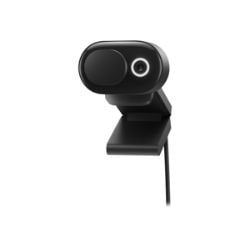-
Do You Need a Webcam?
With many offices and schools operating remotely, a webcam is more important now than ever.
-
What to Look for When Buying a Webcam
Find out what features you should prioritize when looking for a new webcam.
-
Webcam Tips & Tricks
Learn how to make the most of your webcam with these tips.
December 16, 2022
Webcam Buying Guide - Webcam Specifications, Features & More
From types of webcams to specifications and features, this webcam buying guide will teach you everything you need to select the best device for your needs.
Webcams have become a part of everyday life. Finding the best webcam can be the difference between an enjoyable or frustrating remote workday or remote hangout session. From types of webcams to specifications and features, this webcam buying guide will teach you everything you need to know to select the best device for your needs.
Do You Need a Webcam?
For students and office employees working remotely, a webcam is more important now than ever. Most phones have cameras and can suffice in an emergency, but they are often uncomfortable to work on or severely limited by their battery life.
Laptops often have built-in webcams. However, laptop webcams have their own limitations that make them less than ideal for any long work from home or remote school sessions. Also, laptop manufacturers generally will not focus on the quality of built-in webcam components since they are trying to keep their devices competitively priced.
Here are 6 major advantages of an external USB webcam vs. an embedded webcam:
- Higher quality components- Laptop webcams have less space for webcam components. The webcam component quality negatively impacts factors like resolution, image quality color balance and noise reduction for webcams with external mics.
- Focal length adjustment- many external webcams have an autofocus feature, so nearby objects remain crisp and in focus.
- Field of view/positioning- if you want to include more than one person in a video call, external webcams are the way to go, since they have a wider field of view. Plus, many external webcams can swivel 360 degrees, making it easy to adjust what’s in the frame. If you’re looking for further adjustability, you could get a stand for your webcam to get the precise field of view you’re looking for.
- Light filtering- external webcams generally can adjust the image depending on the amount of light in the room.
- Built-in microphone- Laptop mics vary in quality, but most external webcams have better built-in mics than laptops and are designed to work with video calling platforms like Zoom or Webex.
- Fewer overheating issues- external USB webcams are less prone to overheating due to larger casing and therefore more surface area.
Overall, a standalone webcam can provide improved quality and convenience over a phone camera or laptop webcam. Now you’re more aware of the advantages of an internal vs. external webcam, we’ll delve deeper into these features and what you need to look for when buying a webcam.
What to Look for When Buying a Webcam
Depending on what you plan to use your webcam for, there will be certain specifications and features you should prioritize. No matter what you need the webcam for, there are also many quality-of-life features that can benefit any user.
Resolution
As with a monitor or television, resolution is defined as the clarity of a digital image or video. Measured in pixel width by pixel height, here are the three most common webcam resolutions, from lowest to highest resolution:
- 1280 x 720 pixels/720p (HD Ready)
- 1920 x 1080 pixels/1080p (Full HD)
- 3840 x 2160 pixel/4K (UHD)
Webcams generally have a 16:9 aspect ratio, which is considered rectangular or widescreen. Some webcams have an optional 4:3 aspect ratio, which is considered more square-like and was commonly found in pre-2009 computers and TVs.
The more pixels, the finer the image: 720p and 1080p will suffice for most home offices or remote learning tasks. Higher resolution webcams in the 2K or 4K range are overkill for routine video meetings or the classroom but may be perfect for video editing professionals want to record 4K and use/produce later or use the footage for green screening.
Even if you have a 4K webcam, most popular streaming platforms like YouTube and Twitch will downgrade the resolution to 1080p since 4K files are too large (at least for now). Basically, a 1080p webcam is enough for most use cases.
Frame Rate
The frame rate dictates how smooth the video output will be. Frame rate, sometimes referred to as frames per second (fps), is a measure of how many pictures your webcam is taking a second. Since video is a collection of pictures, higher fps gives you more fluid recording and streaming and less choppiness.
Almost all modern webcams are capable of at least 30 fps, which is still considered high quality and is suitable for any occasion, with some being as high as 120 fps. Typically, as you up the frame rate, higher resolutions may not be available. It is common for a webcam to be able to capture 60 fps at 720p and only 30 fps at 1080p.
For first-person shooters, sports games or other player vs. player games that require a high degree of precision, streamers need to conserve bandwidth to prevent lag and often opt for lower resolution for the sake of higher fps.
Basically, higher frame rates, like higher resolutions, are not necessary for most webcam users but can be a must for some professions or hobbies.
Note: the strength of your internet connection, bandwidth, lighting conditions (more exposure needed = lower frame rate), CPU/GPU and your webcam software also play a part in frame rate.
Field of View (FOV)
Field of view (FOV) measures how wide of an area will be captured by a device. Measured in degrees, the values associated with the field of view typically range from 60 to 90 degrees horizontally, vertically and diagonally. Most webcam spec sheets give you the diagonal angle.
The width of the area being captured increases as the number goes up: the higher FOV, the wider the area you will be able to see on the webcam. You could also consider mounting your webcam to a stand and widening out the scope of what it’s capturing that way, another advantage of an external webcam.
Keep in mind that a wider field of view doesn’t necessary mean better. In fact, a narrower FOV often makes more sense for webcam since it’s typically more flattering and you don’t need to capture your background anyway. Some webcam software can help you zoom in a bit more to adjust the FOV, but keep in mind zooming in will reduce your pixel count and degrade your resolution.
Unless you want your audience to see your background or plan on moving around in your space, a webcam with a 60 degree FOV should work just fine, or 78 degrees if you’re looking to also capture a friend and some of your background.
Built-In Microphone
An often-overlooked feature is the webcam microphone. Built-in webcam microphones can eliminate the need for bulky headsets or desk clutter with external microphones, headphones, webcams, and more. Some models have two mics, providing whomever you’re communicating with more natural, binaural sound.
Webcam microphones are often designed to capture the sounds of the entire room and easily capture background sounds, so they may not be the best idea if you live in a noisy environment or working in the same room as someone else. Additionally, you’ll never get the same quality out of a built-in webcam microphone as you would from an external USB microphone or headset.
Autofocus
Autofocus does just as the name implies -- webcams with this feature automatically focus on the person or subject in frame, whether stationary or in motion. This can also be a nice feature for capturing closeups if you’re having a particularly good hair day or capturing the action if you are moving around.
Higher quality autofocus can be better at dealing with multiple light sources, or areas with busy backgrounds. Most modern webcams have autofocus, with some being better or quicker than others. Some webcams will allow you to toggle autofocus on and off.
Autofocus can cause issues in low light environments and will cause the image to come in and out of focus. Also, if you have a prominent object behind you, the autofocus feature may jump to that rather than your face, unintentionally messing up your video. If you have the know-how and are comfortable doing so, it may be best to adjust the focus settings manually within the webcam software. Most of the time, however, the out-of-the-box focus settings should suffice.
Low-Light Correction
Just like with autofocus, low-light correction is a built-in feature in most modern webcams. This feature can brighten and adjust images in dark rooms. Low-light correction is a lifesaver if you need to use your webcam in the early morning or evening and need more than the eerie glow of the monitor to illuminate your face. Multiple light sources can also cause webcams issues, but light correction can help deal with that as well.
Some webcam models also have built-in ring lights with the ability to select the desired level of brightness, which are great at addressing low-light issues. There are also standalone ring lights you could purchase with your webcam which provide more lighting and greater flexibility, with 360-degree horizontal rotation as well as 90-degree vertical rotation.
Plastic Lens vs. Glass Lens
There are two primary types of external webcams: plastic lenses and glass. To put it plainly, plastic is less expensive but sacrifices clarity in the process. Plastic lens webcams can still be great for remote meetings or schoolwork. If you’re looking to use your webcam for streaming at 2K/4K, you would want to avoid a plastic lens. It’s very likely webcams capable of these resolutions wouldn’t have a plastic lens anyway. Webcams with plastic lenses are also more easily scratched than webcams with glass lenses.
The highest quality webcams will have glass lenses. This allows for the device to have incredible resolutions up to 4K and is perfect for content creators or anyone looking to get the clearest, cleanest video and image quality as possible from their webcam.
Green Screening
Special effects are not just for the big screen. Many modern webcams have some form of green screen or chroma key effects so you can do green screening without an actual green screen. While not required for most remote tasks, special effects are great for blocking a busy background or specific tasks like school projects. Webcams that support this feature can change your background to any image.
If you’re a streamer looking to utilize a webcam with green screen capabilities for streaming or recording video, webcam resolution is more important than for your average webcam user. Higher resolution makes it easier for the software to discern the subject from the background. Greater resolution will make it easier to chroma key the background when using a green screen and less headache later when you’re producing your recorded video.
If you’re serious about green screening and content creation, you may be better off with a traditional green screen backdrop or collapsible green screen kit, depending on how much background you’re looking to green screen and if you plan on being in motion. For most casual users, the software offered by webcams should work fine, provided you have good lighting.
Software Support
Some of the more high-end webcams come with a full range of software support. Software features can range from anything previously mentioned in this list to other functions like slow-mo effects and RGB sync. The main benefit of having a webcam with software support is that it gives you more control over every aspect of the device. The software will allow you to see and set resolutions, frame rates and zoom. Every webcam is different, so be sure to check if a device comes with software and what features it offers.
Webcam Tips & Tricks
To round out this webcam buying guide, here are few tips and tricks for getting the most out of your new webcam.
Typical Angles
While external webcams allow for all kinds of viewing angles, some are considered more professional than others. The most common and pleasant viewing angle is looking slightly down or to one side, with the person communicating centered in the frame. Often, there will be a preview of your video before you go live in any app. Use that time to experiment and find viewing angles that work best for you.
The portability of external webcams allows for attaching to a stand or mounting clamp. This provides complete freedom when it comes to positioning your webcam, with many stands having 360 rotation and, in some instances, a bendable and extendable arm.
Before purchasing a webcam stand, make sure the stand is compatible with the mounting screw on your webcam (or if you webcam has a mounting adapter at all). Typically, they’ll have a ¼” adapter, which is pretty standard across webcams.
Quality Adjustments
If you find your webcam is not looking like it should, you could try reinstalling or updating the device's drivers. When webcams come with software, there will likely be controls within your operating system to adjust resolution or frame rate as well. You can prioritize resolution if you need a clear picture and will not frequently be moving. Conversely, you could prioritize the frame rate and autofocus if you need to capture any fast-moving actions or presentations.
Cleaning
As with any piece of technology, unplug the device before attempting to do any maintenance. Once unplugged, spray glass cleaner onto a microfiber cloth or paper towel, never the device itself. Then gently use the cloth to clean the lens to ensure no dust or dirt is building up that could damage it. You can also use an air duster to remove excess debris from any part of the webcam safely.
Security & Privacy
The best way to ensure that your webcam is safe from malicious parties is to unplug it. If your device is unplugged, no hacker or scammer in the world could get access to it. With built-in webcams, however, unplugging your webcam is not possible. In that case, the best solution is to purchase a lens cover. The device is inexpensive and straightforward, providing an excellent way to physically hide the video from your webcam. Lens covers typically clip to the device itself and can be quickly closed or opened to hide or share your video.
Summary
Using a webcam has become commonplace. Because of that, you may need to buy a better device. We hope this webcam buying guide helps you understand all the specifications and features you need to find the right device for you.
External webcams have a number of features and benefits that can make working remotely much more comfortable. Special features such as autofocus and built-in microphones can make the difference between a smooth video conference or annoying technical difficulties. Hopefully, after reading this guide, you feel confident in your webcam knowledge and can find the best device for your needs.



